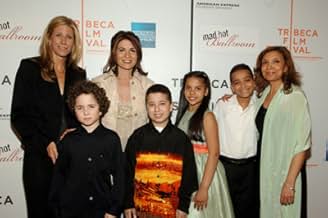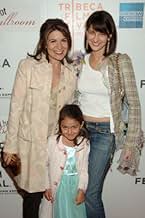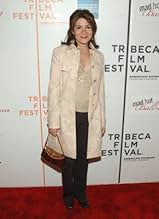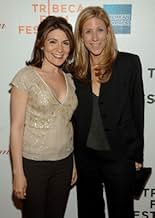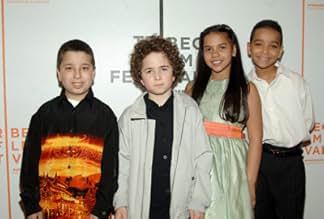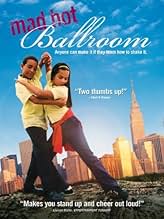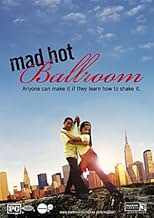IMDb-BEWERTUNG
7,4/10
3585
IHRE BEWERTUNG
Die Schüler mehrerer Grundschulen in New York City lernen Gesellschaftstanz und nehmen an einem stadtweiten Tanzwettbewerb teil.Die Schüler mehrerer Grundschulen in New York City lernen Gesellschaftstanz und nehmen an einem stadtweiten Tanzwettbewerb teil.Die Schüler mehrerer Grundschulen in New York City lernen Gesellschaftstanz und nehmen an einem stadtweiten Tanzwettbewerb teil.
- Auszeichnungen
- 8 Gewinne & 10 Nominierungen insgesamt
Empfohlene Bewertungen
I loved this movie. I laughed and cried. These children made me want to embrace them. They were such a joy to watch, their determination was astonishing. They had so much courage. I commend them. I looked on the internet the next day and searched for a dance school for my friend and I and we're starting next week. I just hope we're as good as those kids. Excellent movie. All children should see this movie to show them that you don't have to have money to enjoy life. Most of these children were living at or below poverty level and they prevailed. They have more heart then most adults I know. I'm going to go see it again and I can't start advocating to others to see it as well.
NYC has a 10 week Phys. Ed program that teaches ballroom dancing to 5th graders. Some of those kids can elect to join a team, similar to one in football, basketball, track, etc. -- of inter-school competition. This documentary follows the development, training, and competition of some of those teams.
While learning to dance and the competition is the overlying central theme of the narrative, the film is about far more.
Fifth graders will be typically six years old PLUS their grade level -- so most will be about eleven while some are 12 and a few are 10 years old. These students are at -- or a few degrees either side -- of the cusp of puberty. That stage is also graphically reflected in their heights --some are barely above 3 feet while others approach six. Many of the kids come from neighborhoods in which most are disadvantaged, crime ridden, and fractured families while some are from the reverse.
The film brings back to us what it was like to be a kid (and maybe wonder which of those we see here that we would have been most like?), the whole process of learning, of growing up, of the transition of thoughts and expectations kids have about what lies beyond puberty, the relation between caring adults (teachers) and children, the emotions teachers have about the ones they lose and the ones they win, etc.
I've often wondered if -- maybe -- many of us have a hidden, secret talent -- to be a Serena Williams, a Yo Yo Mah, Carol King, W.H. Auden, Charles Eames, etc. -- but our hidden talent has never been discovered.
The NYC program filmed here discovers some of those talents that would otherwise remain hidden. And this documentary shows, through the lens of dancing, some of the process of a crucial stage in human development and our dependence on our peers and empathic teachers/mentors.
And all of this is done without a voice over narration. At times I was a little confused about which kids of which school we were watching. But I learned to relax -- it's the panorama that's most important.
Great film.
It takes "Spellbound" as a model and advances it.
I'd welcome seeing 50 films of this quality a year.
While learning to dance and the competition is the overlying central theme of the narrative, the film is about far more.
Fifth graders will be typically six years old PLUS their grade level -- so most will be about eleven while some are 12 and a few are 10 years old. These students are at -- or a few degrees either side -- of the cusp of puberty. That stage is also graphically reflected in their heights --some are barely above 3 feet while others approach six. Many of the kids come from neighborhoods in which most are disadvantaged, crime ridden, and fractured families while some are from the reverse.
The film brings back to us what it was like to be a kid (and maybe wonder which of those we see here that we would have been most like?), the whole process of learning, of growing up, of the transition of thoughts and expectations kids have about what lies beyond puberty, the relation between caring adults (teachers) and children, the emotions teachers have about the ones they lose and the ones they win, etc.
I've often wondered if -- maybe -- many of us have a hidden, secret talent -- to be a Serena Williams, a Yo Yo Mah, Carol King, W.H. Auden, Charles Eames, etc. -- but our hidden talent has never been discovered.
The NYC program filmed here discovers some of those talents that would otherwise remain hidden. And this documentary shows, through the lens of dancing, some of the process of a crucial stage in human development and our dependence on our peers and empathic teachers/mentors.
And all of this is done without a voice over narration. At times I was a little confused about which kids of which school we were watching. But I learned to relax -- it's the panorama that's most important.
Great film.
It takes "Spellbound" as a model and advances it.
I'd welcome seeing 50 films of this quality a year.
10jotix100
This sunny documentary on a rainy and gloomy afternoon was the perfect movie to watch. "Mad Hot Ballroom" directed by Marilyn Agrelo, who is working with her collaborator, Amy Sewell, will put anyone into a good mood because it's a disarming view at inner city children who have benefited a lot from this experience.
What comes across in the documentary is the tenacity in which the teachers keep these children involved as they are exposed to another world many of them don't even know exists. The teachers one sees in the film are clearly people that ought to be commended for motivating children that otherwise would probably be in the streets hanging out and getting in trouble.
Yomaira Reynoso and Allison Sheniak are seen openly crying when describing what they are trying to give these youngsters. It shows their devotion to the children that comes from their hearts. It's a rare thing to find men and women whose lives are given to the cause of shaping these youngsters under their care. The other teachers also have to be singled out for their dedication, especially Rodney Lopez and Alex Tchassov.
Three public schools are shown preparing for the competition, but only three are singled out, one in Tribeca, one in Brooklyn and one in Washington Heights. The children featured in the different segments are caught being themselves. There seems to be an air of improvisation in the way Ms. Agrelo points the camera to whatever is going on. The kids come out so natural in being themselves, no small achievement for this, or any other director.
It is to Ms. Reynoso's credit to dress all the six couples of her team in such a colorful, yet modest, way they have a dignified and professional look. These children of Washington Heights are poor, but they clearly show they are there to win, despite of competing with other, more affluent, schools. In a way, Ms. Reynoso has achieved in showing by her example how to be a better person.
The dancing in all the different categories at the finals show all teams in great form. Some of the dancers show a grace and a joy for whatever they are dancing at the moment. This is reflected in some of the judges, especially Ann Reinking, who seems happily surprised by some of the kids on stage.
The reaction of the audience at the session we attended couldn't have been more positive. The energy of the music and the dancing make a perfect combination. Ms. Agrelo is to be congratulated for capturing these New York school kids that show an amazing group of young and talented people that are a delight to watch.
What comes across in the documentary is the tenacity in which the teachers keep these children involved as they are exposed to another world many of them don't even know exists. The teachers one sees in the film are clearly people that ought to be commended for motivating children that otherwise would probably be in the streets hanging out and getting in trouble.
Yomaira Reynoso and Allison Sheniak are seen openly crying when describing what they are trying to give these youngsters. It shows their devotion to the children that comes from their hearts. It's a rare thing to find men and women whose lives are given to the cause of shaping these youngsters under their care. The other teachers also have to be singled out for their dedication, especially Rodney Lopez and Alex Tchassov.
Three public schools are shown preparing for the competition, but only three are singled out, one in Tribeca, one in Brooklyn and one in Washington Heights. The children featured in the different segments are caught being themselves. There seems to be an air of improvisation in the way Ms. Agrelo points the camera to whatever is going on. The kids come out so natural in being themselves, no small achievement for this, or any other director.
It is to Ms. Reynoso's credit to dress all the six couples of her team in such a colorful, yet modest, way they have a dignified and professional look. These children of Washington Heights are poor, but they clearly show they are there to win, despite of competing with other, more affluent, schools. In a way, Ms. Reynoso has achieved in showing by her example how to be a better person.
The dancing in all the different categories at the finals show all teams in great form. Some of the dancers show a grace and a joy for whatever they are dancing at the moment. This is reflected in some of the judges, especially Ann Reinking, who seems happily surprised by some of the kids on stage.
The reaction of the audience at the session we attended couldn't have been more positive. The energy of the music and the dancing make a perfect combination. Ms. Agrelo is to be congratulated for capturing these New York school kids that show an amazing group of young and talented people that are a delight to watch.
It's been two glorious weeks for us award-winning teachers. Last week I reviewed the documentary Rock School, a raucous romp with teens from Philly grooving Zappa all the way to Germany. This week's Mad Hot Ballroom shows the NYC public schools competing for top honors in ballroom dancing, a required course that lets students and teachers, supplied by the American Ballroom Theater, strut their best stuff in the tango, rumba, meringue, and foxtrot.
Like last year's Spellbound, everyone gets to show competitive spirit with low-level anguish at losing and testosterone-fueled joy at winning. The strength of Ballroom is the enthusiasm of teachers who have little to gain but the biggest prize of allthe success of their charges. Fairly absent is the dominance of stage-door parents in the spelling competition. Ballroom better captures the harmony that pervades a group project where the human body gracefully expresses its glory and young people experience perhaps for the first time the wonder of collective activity that ties them to peers and teachers and effaces their natural youthful loneliness, delinquent temptations, and fear of losing.
Some will criticize Ballroom for showing too many contestants and thereby losing the intimacy documentaries thrive on. Yet, the eventual winners stand out from the first moment they appear, almost exonerating director Agrelo from the intimacy requirement; also, that communal experience is better explained through the roving camera and long shots of their dancing. Although Ballroom may be too long by as much as 15 minutes, I admit I would have liked to linger more with some of the children to see how their lives have been changed by the experience; Agrelo lets the voice over take care of a couple of histories.
Cinematographer Claudia Raschke's camera, held level with the children's faces, does its own winning dance with us as viewing partners. You'll want to put on your dancing shoes after this film.
Like last year's Spellbound, everyone gets to show competitive spirit with low-level anguish at losing and testosterone-fueled joy at winning. The strength of Ballroom is the enthusiasm of teachers who have little to gain but the biggest prize of allthe success of their charges. Fairly absent is the dominance of stage-door parents in the spelling competition. Ballroom better captures the harmony that pervades a group project where the human body gracefully expresses its glory and young people experience perhaps for the first time the wonder of collective activity that ties them to peers and teachers and effaces their natural youthful loneliness, delinquent temptations, and fear of losing.
Some will criticize Ballroom for showing too many contestants and thereby losing the intimacy documentaries thrive on. Yet, the eventual winners stand out from the first moment they appear, almost exonerating director Agrelo from the intimacy requirement; also, that communal experience is better explained through the roving camera and long shots of their dancing. Although Ballroom may be too long by as much as 15 minutes, I admit I would have liked to linger more with some of the children to see how their lives have been changed by the experience; Agrelo lets the voice over take care of a couple of histories.
Cinematographer Claudia Raschke's camera, held level with the children's faces, does its own winning dance with us as viewing partners. You'll want to put on your dancing shoes after this film.
10Ed-90
At first, I told my wife I didn't want to go. I thought it was yet another movie of McDonalds generation 11-year-olds, snotty and attitudinal, populated with stupid, bumbling adults trying to please them. I was very, very wrong. It was one of the best movies I've seen in years. It had meaning, warmth, humor, pathos--you name it. It had real adults, and real kids. Real teachers who were not afraid to be clear, loud and firm with kids, but with a great deal of love for them--and vice-versa. Plus, it makes you fall in love with NYC. I want to see the film again, and I can't recommend it enough. Hey, it's appropriate for everyone, too. (By the way, look for the lady who played Oliver Warbucks' assistant Grace in the movie "Annie"--she's a real dancer and one of the judges at the end.) In sum: don't miss this magic film.
Wusstest du schon
- WissenswertesThe three schools that the film follows are: PS 150 from the affluent Tribeca area; PS 112 from the primarily Italian and Asian area of Bensonhurst; and PS 115 from Washington Heights, a Dominican neighborhood where over 97% of the residents live below the poverty line.
- Zitate
White chubby kid: My religion does not allow me to dance, and Mouhamed's does not allow him to dance either, so we have really enjoyed being DJs.
Mouhamed: Everybody has been very nice to me, although... I am... from another...
[hesitates]
Mouhamed: country.
- Crazy CreditsSome of the children add their observations about life in film clips during the credits.
- VerbindungenFeatured in Late Night with Conan O'Brien: Al Franken/Fountains of Wayne (2005)
- SoundtracksFEVER
by Peggy Lee
Top-Auswahl
Melde dich zum Bewerten an und greife auf die Watchlist für personalisierte Empfehlungen zu.
- How long is Mad Hot Ballroom?Powered by Alexa
Details
Box Office
- Bruttoertrag in den USA und Kanada
- 8.117.961 $
- Eröffnungswochenende in den USA und in Kanada
- 45.348 $
- 15. Mai 2005
- Weltweiter Bruttoertrag
- 9.104.327 $
- Laufzeit
- 1 Std. 45 Min.(105 min)
- Farbe
- Sound-Mix
- Seitenverhältnis
- 1.85 : 1
Zu dieser Seite beitragen
Bearbeitung vorschlagen oder fehlenden Inhalt hinzufügen



